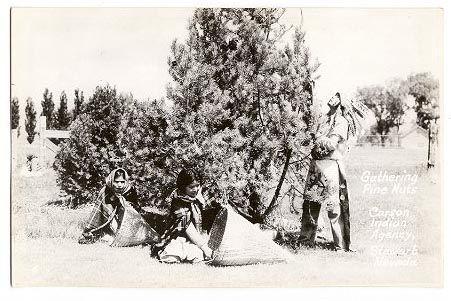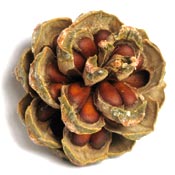Pine nuts, Politics and Public Lands

Lastyear we imported 8 million pounds of pine nuts from seven countries. Prior to World War II, millions of pounds of fresh American pine nuts were harvested here and available to U.S. consumers. What happen to our own pine nut harvest?
All pine trees reproduce through creating a nut in a cone. Some of these pine nuts are tasty and nutritious - others cost more in calories to collect, than they yield. The pinenuts purchased at a grocery, could be from any one of the 28 species, grownin about 7 countries. Each species with a different , shape, texture, flavor and nutritional value.The Department of Commerce reports that foreign countries shipus, 8 million pounds of pinenuts each year. China provides most of the imported nuts, with Italy, Pakistan and Portugal, each being a major exporter of pinenuts. Becausethe shell amounts to 25% of the shipping weight, most nuts are sold withthe shells removed. Once the shell has been removed, the nut must be preserved.Pine nuts are preserved, according to methods of the exporting country.Certain methods of preservation would not be allowed here, like the useof lye as preservative. Unless you live in the Southwest, or are over theage of 70, chances are you have never had a fresh, unprocessed pinenut.One might compare this to never having eaten a fresh strawberry, but consumingonly dried or frozen fruit. Yet, two American species of pine nuts growwild on 47 million acres of public land. It is a native plant, with tremendousrange, outstanding nutritional value, and highly sought after in foreigncountries. Why then are we importing so many pine nuts?
POLITICS OF PUBLIC LAND and Special Interests
The politics of the Western cattle industry and public land grazing is the primary reason From 1950-72 the USFS and BLM cleared ("chained") over 3,211,000 acres of pinion-juniper to create grazing land. Before the huge corporations controlled grazing permits, pine nuts were harvestedby the box car load and readily available. Those were the days before thechain-saw, bull dozer, massive herbicide treatments, the American Cattle’s Association and the Bureau of Land Management (BLM). The days before large expanses of maturing pine nut trees were destroyed to grow grass for cattle--- at taxpayer expense.
Pinyon pinenuts sustained the native peoples of the Great Basin for over 10,000 years. The soft-shelled pinyon pinenut, (p.monophylla) providedprimary protein to the Shoshone, Piautes and Washo peoples, containingsubstantial amounts of the amino acids necessary for human growth. It wasa sacred part of the way they lived. Between 1865 to 1877, Native lands had been overrun withcattle and sheep. The pinion pines, which they depended upon for a pinenut crop each fall, were rapidly being cut down for fuel for the mine smelters.Smelting a ton of ore required from twenty-five to thirty-five bushels ofcharcoal. The mills at Eureka consumed as much as 1.25 million bushels ofcharcoal a year, destroying the Indians' pine nut groves .
Certain treaties and Nevada laws provide harvest rights to Natives. The Native Peoples havenever fought for those rights. The Federal Government cannot be guaranteedeconomic control of the pinenut harvest.
Corporate cattlemen pay minimal grazing fees and the taxpayers subsidize the land treatment, to create the gazing lands, yet cattle won, hands down, over pinenuts as a public land use.
Most public lands managers are educated as range managers, rather than foresters. Range managers see it as their self-imposed duty to create and maintain range, which can also be called pasture. Millions and millions ofacres of pinyon forests were bulldozed, chained, poisoned and subjected toprescribed burning to create pasture land for cattle. Beginning in the 1960‘s the pinyon tree were treated as a invasive weed, interfering with theforage available for cattle.
Range managers were never educated about the massive deforestation caused 1800’s mining industry which fueled the silver smelters with pinyon charcoal at a rates up to 450 acres per day. Nor, have they been taught that the p.monophylla life cycle requires between 100 and 150 years to reach seed bearing maturity, then cones on a 5 year cycle, with three seasons required to produce the nut in the cone. Most have never read the research reports that state pinenut production potential revenues could exceed grazing revenues by 148 to 500 times over. Or, that pinenuts are 28 times more earth efficient in terms of acreage used to produce pounds of protein than beef.
The Great Basin was a semi-arid forest and native peoples could always find a harvest of pinenuts, before white settlement. The pinyon never recovered from demands made upon it by the mining industry of the 1800’s. The large, mature seedstock trees had been depleted from all but the most inaccessible areas of the forest. As the cattlemen came in, the land was manipulatedto yield grasses, rather than forest. The grasslands dry out and die, rather than maintain the moisture content, like trees. The pasture land has become part of the catalyst for huge fires in
Nevada.
Land managers again, rather than looking to long term historical landcomposition, used faulty logic to justify treatment projects as landscaperestoration, creating more grassland and flash fuel. Deforestation. Thisin turn, dramatically reduced the mature pine nut bearing tree.
One can obtain more information about pinyon pine nuts and public land activism from www.pinenut.com. The owners of that site are environmentalist working to promote wild food as an alternative to cattle grazing.
Penny Frazier is independent environmental advocate, who has spent the last 8 years working to create change on public lands. She is a former litigation paralegaland the owner of the www.pinenut.com . She actively participates in publicland management NEPA proceedings, receiving training and encouragementfrom the Committee for Idaho's High Desert (www.CIHD.org) . She works atrespecting the Western Shoshone Nation and supports justice for their LandSettlement Claims.
Site Pages
Overview of BLM land policy
Sort of a summary of BLM attitude
For More Details and Links go to our home page
ORDER Page
Penny Frazier
penny@pinenut.com
573.674.4567
Licking Wild Nuts Co.
Licking MO. 65542




